Soybean contains approximately 40% protein in the grain, which is rich in nitrogen (N); therefore, soybean needs for N are high.
Introduction
Unlike corn, wheat and most other row crops grown in North America, soybean is able to obtain its own nitrogen (N) through the process of N fixation. N fixation is achieved through an intricate biological relationship between soybean and a particular species of soil bacteria, Bradyrhizobium japonicum.
The bacteria obtain sugars from soybean to use as their energy source, and soybean obtains N from the bacteria. This is a fair deal for soybean and a great deal for farmers, given that N is generally a major input cost in crop production.

|
| Soybean has high protein content, which is rich in N, so its needs for N are high. |
Because soybean can fix its own N, farmers have traditionally taken a "hands-off" approach to N fertilization. The exception is in fields not recently planted to soybean, in which case a seed-applied "inoculant" of rhizobia bacteria has been used. This has been the extent to which most growers have worried about N fertilization for soybean, and it has largely been a successful approach for over half a century.
Today, however, some soil fertility recommendations for soybean are including N fertilizer applications, often in the range of 20 to 40 lbs/acre but sometimes higher. At the same time, other recommendations are consistent with conventional wisdom - inoculating new soybean fields with rhizobia and nothing more. These varying recommendations may have growers wondering what has changed. The answer is that soybean fertility guidelines are evolving to account for increasing N demand from higher-yielding soybean. This article will discuss the N needs of today's higher-yielding soybean crops, sources of N supply to the crop, and whether N fertilizer applications may be needed for maximum soybean yields.
N Demand Of A Soybean Crop
When soybean is harvested, a large amount of N is removed from the field. This is because soybean grain has high protein content (~ 40% or more on a dry weight basis), and protein contains about 16% N. For example, 60 bu of soybean contains ~210 lb N in the grain and ~80 lb N in the above-ground residue, totaling ~290 lb N (Salvagiotti et al., 2008). This is more N than a high-yielding corn crop requires - 200 bu of corn contains a total of 270 lb N in the above-ground plant portion (Bender et al., 2013).
Table 1 demonstrates that soybean contains a relatively large amount of N in the grain; an important question is: "How much of this can come from N fixation and how much can come from the soil?"
Table 1. Approximate lb N in various crops.
| Crop | ~ lb N in seed | ~ lb N in stover |
Total lb N in seed + stover |
|---|---|---|---|
| 200 bu corn | 156 | 114 | 270 |
| 60 bu soybean | 210 | 80 | 290 |
| 80 bu soybean | 280 | 107^ | 387^ |
| 100 bu soybean | 350 | 133^ | 483^ |
^ estimated.
Sources Of N For A Soybean Crop
Based on the common soybean management approach of not adding N fertilizer, soybean receives its N from only 2 sources: N fixation and soil N (residual N and mineralization of organic matter). A recent review of scientific papers compared the N demand of high-yielding soybean to the capacity of soybean to fix N from the air and obtain it from the soil (Salvagiotti et al., 2008). Because N concentration in soybean seed is fairly constant, N plant uptake from fixation and soil sources increases proportionally to grain yield (Figure 1).
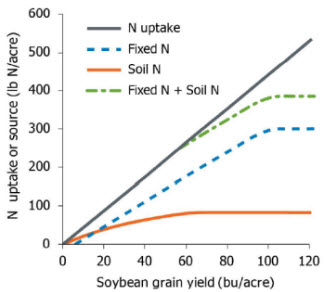
|
| Figure 1. A generalized N budget for soybean (adapted from Salvagiotti et al., 2008). |
As Figure 1 indicates, average N fixed by soybean increases linearly with increasing yield, but only a portion of the total N requirement is met through N fixation (about 50% to 60% of total N requirements at yields of 50 bu/acre or less). Based on the average of the 100+ studies represented in Figure 1, at a yield level of 60 bu/acre, fixed N provides about 180 lb of the 270 lb N uptake in soybean, or 65% to 70% of the total required N. For yields up to 60 bu/acre, the difference between total N uptake (i.e., plant requirement) and fixed N is usually provided by soil sources.
The N budget in Figure 1 also illustrates that there may be a small N deficit for yields between 60 and 80 bu/acre, which means that yield could be restricted because of too little N. Realistically, conditions that are favorable for top soybean yields are usually conducive to high soil mineralization as well, so N would not always be limiting in the 60 to 80 bu/acre range.
However, as soybean yields continue to increase and yields in this range and higher become more common, N fixation and soil N mineralization will reach capacity in many growing environments. Thus, an increasing number of N shortfalls are almost certain to occur based on the current understanding of this system, particularly at yields near 100 bu/acre.
As the graph shows, soybean's upper limit for N fixation (considered to be about 300 lb/acre) combined with the upper limit of the soil supply (usually less than 100 lb/acre) are insufficient to meet the needs of a 100 bu/acre soybean crop (Salvagiotti et al., 2008).
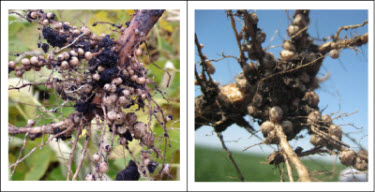
|
| Soybean roots showing excellent nodulation. |
Understanding Soybean N Needs By Comparing To Corn
Another approach to understanding soybean N needs is to compare it to corn, a crop for which growers routinely estimate N needs. Consider a situation of growing corn without application of N fertilizer: if soils can provide 80 lb N by mineralization, resulting corn yields may approach 100 bu/acre, which contains 80 lb N in the grain. To achieve corn yields above 100 bu/acre would require supplemental N beyond what soils are able to apply, i.e., application of N fertilizer. This same 80 lb N supplied by the soil, when added to N fixed by the soybean crop, is sufficient to produce 50 to 60 bu/acre of soybean (Figure 1); achieving higher yields may require supplemental N.
N Credit For Corn Following Soybean?
The N budget also makes an important point about the prospect of an "N credit" from a soybean crop that may reduce the N fertilizer requirement for a subsequent corn crop. Because soybean does not fix enough N to satisfy its own needs, but rather, removes N from the soil at both low and high soybean yield levels, the concept of an N credit is not supported. Nevertheless, the practice of applying less N to a corn crop following soybean is still valid, but for a different reason.
Soil microbes that digest crop residue use the carbon (C) remaining in plant materials as an energy source. As microbial populations increase in the presence of carbon-rich residues, they also require N for cellular growth and metabolism. Because most crop residues are high in C but not in N (C:N ratio is high), microbes use N that is available in the soil. This temporarily “ties up” the N, making it unavailable for other uses, including crop uptake.
Eventually, however, N is released back to the soil as crop residues are decomposed and microbial populations decline. Soybean crop residue contains considerably more nitrogen than corn residue, which speeds up the process of residue decomposition and ties up less N in the subsequent corn crop. Thus, less N needs to be applied to corn following soybean.
Research Studies Regarding Source Of N For Soybean
Several research studies have investigated the sources of N supply to soybean. Of these, 3 key studies indicated that between 45 to 90 lb N/acre is provided by mineralization of soil N.
- Using non-nodulating soybean, a study from southern Minnesota showed that 85 lb N/acre accumulated in the soybean crop without any additional N fertilizer (Schmidt et al., 2000).
- Results from a similar study indicated that between 45 and 90 lb N/acre accumulated in non-nodulating soybean without any N fertilizer (Thies et al., 1995).
- Salvagiotti et al. (2009) assumed that as much as 90 lb N/acre could be obtained from a fertile soil in Nebraska.
Based on these studies, a value of 85 lb N/acre was used in Figure 1 as the maximum amount of N available to soybean from soil mineralization.
The southern Minnesota study also provided insights into an important, often-asked question about N supply to soybean: How does the availability of soil and fertilizer sources of N affect nodulation and N-fixation? The yield of the non-nodulating soybean increased with increasing rates of N fertilizer (Figure 2).
However, the yield of the nodulating soybean did not vary with the fertilizer application rate but was at or near the maximum yield obtained in the study, regardless of the amount of N supplied by fertilizer (Figure 2). This suggests that the nodulating soybean was able to completely compensate for the less-than-sufficient N supply by fixing the remaining N needed for optimum yield (Schmidt et al., 2000).
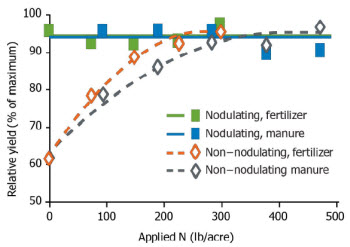
|
| Figure 2. Relative yield of nodulating and non-nodulating soybean with varying rates of fertilizer or manure applied (Schmidt et al., 2000). |
To summarize, soybean requires a large amount of N. Because only a portion of this can be supplied by N fixation and soil mineralization, growing higher-yielding soybean will likely require another source of N.
The Challenge Of Applying N Fertilizer To Soybean
Recommendations vary
There is neither clear proof from the scientific literature nor consistent anecdotal evidence from growers to predict the conditions leading to a soybean response to fertilizer N. In instances where soybean has responded to N fertilizer, the contributing factors have seldom been positively identified. Still, a variety of recommendations can be found:
- Some suggest that less fertile soils or those that mineralize less N (e.g., soils with low soil organic matter content) are good candidates for producing a soybean response to N fertilizer.
- Others indicate that N fertilizer applied in the zone of N fixation (near the surface in the root zone) will inhibit N fixation, and the benefit of the additional N fertilizer is offset by less fixed N.
- Timing of application is also unclear; some recommendations are to apply N fertilizer during the early part of the growing season (before reproductive stages), while others indicate to apply during pod fill when the plant's demands for N are greatest.
These recommendations are not always based on research results. For example, scientists have not yet been able to identify precisely when soybean will respond to N fertilizer and therefore, when to apply it. On the other hand, research on N fixation in the presence of soil nitrate is much more consistent.
Soil Nitrate Levels Limit N Fixation
Research results have clearly shown that N fixation by soybean is inhibited in the presence of elevated levels of soil nitrate (NO3). This means that when N fertilizer is applied, soybean simply fixes less N.
From a physiological perspective, this makes sense because the process of initiating the symbiotic relationship with rhizobia is energy-demanding. If soybean can avoid the additional "expense" of fixing N by obtaining inorganic N already present in the soil, it will forego, or at least postpone, N fixation. Because all N fertilizers ultimately change to the nitrate form in the soil, this limitation applies to all N-containing fertilizers.
The less certain aspect of this problem is whether soybean will compensate with N fixation when soil N and/or N fertilizer is completely used up. Results from a comparison of nodulating and non-nodulating isolines of the same soybean variety seem to suggest that N fixation does compensate adequately when N fertilizer is applied at levels less than required to obtain maximum yield (Schmidt et al., 2000).
Because N fixation appears to perfectly complement any fertilizer and soil N, it is not advantageous to apply more N fertilizer than necessary; rather, growers should leverage N fixation to the maximum, as this N source is available at little or no cost.
Timing of N Fertilizer Application
Because research on timing of N application to soybean has not produced consistent results, the question of optimum timing remains unanswered. However, understanding more about a soybean plant's variable needs for N throughout its life cycle can provide some guidance for application timing. Nitrogen demand by soybean is illustrated in Figure 3.
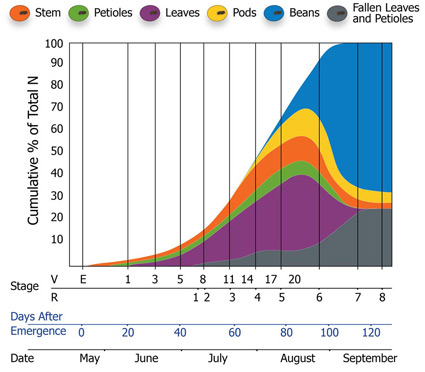
|
| Figure 3. Nitrogen uptake of soybean by growth stage and date for various above-ground plant tissues. Adapted from Ritchie, et al., 1982. |
At about 60 days after planting, or about the R4 growth stage, soybean begins to move N from the vegetative parts of the plant to the grain. This might suggest that the best time to apply additional N is prior to R4 (during the early reproductive growth stages) so that fertilizer N is readily available to the plant by R4.
If this applied N could delay or minimize the shift of N from the vegetative parts to the seed, it may prolong the duration when the plant remains green and is moving carbohydrates to the seed, and therefore may increase overall grain yield.
Although an N fertilizer application during early reproductive growth stages is during a period of great demand by soybean, it is not known if the N applied would be additive to the N fixed by the plant. Conversely, it could decrease N fixation by some amount, even up to the total quantity of N fertilizer applied, thus resulting in a zero net gain in available N to soybean. Unfortunately, as stated previously, there is not a straightforward answer at this time.
Supporting Research: A Slow-Release N Study
How might N fertilizer be applied to soybean without adversely affecting N fixation? An approach taken in a Nebraska study was to apply 160 lb N/acre of slow-release N fertilizer (polymer coated) before planting and place it 8 inches below the soil surface midway between the rows (Salvagiotti et al., 2009).
The placement at 8 inches depth was intended to avoid or minimize the reduction of N fixation, since this put the N fertilizer below the zone where most N fixation occurs. Using a slow-release form of N allowed the application to be made prior to planting but delivered the N fertilizer closer to the plant's peak demand (during reproductive growth stages).
In this Nebraska study, the deep placement of slow-released N fertilizer was compared to broadcast applications of ammonium nitrate either split before planting and at the V6 growth stage or all applied at the R5 growth stage. The check treatment had no N fertilizer applied.
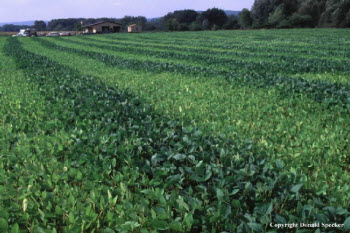
|
| Field with soybean planted for the first time. Dark strips were inoculated with rhizobia bacteria; light strips were not. |
The results showed that grain yields from all 3 N treatments were the same, achieving 81 bu/acre, which was 3.6 bu/acre greater than the untreated check. This relatively small yield response to N did not justify applying 160 lb N/acre. It is unknown whether less N fertilizer would have been sufficient to increase yield.
Results also showed that the deep placement of slow-release N fertilizer was successful in not reducing the amount of N fixed by the soybean, as the 180 lb N/acre fixed by the plant for this treatment was the same as that fixed by the check treatment. This compared to 140 lb N/acre fixed for the broadcast ammonium nitrate treatments. However, the N fixed in this study was considerably less than average for 80 bu/acre soybean (220 lb N/acre) when compared to the many studies represented in Figure 1.
Additionally, N uptake attributed to soil was between 160 and 200 lb N/acre - much more than typically attributed to soil mineralization (80 to 100 lb N/acre). For this Nebraska study, fixed N plus soil N totaled 340 to 380 lb N/acre, which is usually sufficient to produce 80 bu/acre soybean (Figure 1). Thus, the lack of response to the N fertilizer could have been a consequence of a soil that was already providing plenty of N by mineralization.
Conclusions
The N budget shown in Figure 1 illustrates the approximate total amount of N needed by a soybean crop at various yield levels, as well as the average amounts of N provided by soil mineralization and N fixation. According to this budget, N from soil and N fixation becomes limiting to yield at average soybean yield levels between 60 and 80 bu/acre. This N deficit grows as yields increase above 80 bu/acre, raising the possibility of a need for N fertilizer or manure to supplement natural sources.
Research studies have not consistently identified the conditions for yield increases from supplemental N applications. However, this budget, which was derived from a summary of over 100 research studies, may represent the best estimate of N supply from various sources and resulting sufficiency or need in soybean production.
The inconsistency of N response in scientific studies is likely because most soybean yields were restricted to below 60 bu/acre by diseases, nematodes, drought stress or other factors. It is only when these and other production limitations are removed that N becomes yield limiting. As higher soybean yields become more common due to improvements in genetics and management practices, N additions may be needed to maximize potential yields.
Nitrogen needs that are unmet by the combination of N mineralization by the soil and N fixation by the plant can be supplied by other sources such as N fertilizer or manure. These supplemental N needs to meet crop demands are shown below for various soybean yield levels.1,2 These are based on the potential N deficit (difference between N supply and crop needs) shown in in Figure 1 for soybean yields above 60 bu/acre.
|
Even when soybean needs for supplemental N have been identified, a critical question remains - will N additions be cost-effective? That question will only be answered over time with broad-based research studies and side-by-side comparisons in growers' fields.
With that in mind, the best approach to determine if supplemental N is required for your soybean field may be to simply try a low rate of N in alternate strips on a few acres. If a cost-effective yield increase is observed with 20 to 30 lbs N/acre, then consider testing an even higher rate.
With the availability of precision farming technologies, many growers can directly evaluate the merits of an N fertilizer application to soybean on a field-by-field basis. Knowledge of which soybean fields respond to additional N fertilizer is valuable information for future soybean crops.
Resources
Bender, R.R., J.W. Haegele, M.L. Ruffo, and F.E. Below. 2013. Nutrient uptake, partitioning, and remobilization in modern, transgenic insect-protected maize hybrids. Agron. J. 105:161-170.
Ritchie, S.W., J.J. Hanway, and H.E. Thompson 1982. How a Soybean Plant Develops. Iowa State University Coop. Ext. Special Report no. 53. Ames, Iowa.
Salvagiotti, F., J.E. Specht, K.G. Cassman, D.T. Walters, A.Weiss, and A. Dobermann. 2009. Growth and nitrogen fixation in high-yielding soybean: Impact of nitrogen fertilization. Agron. J. 101:958-970.
Salvagiotti, F., K.G. Cassman, J.E. Specht, D.T. Walters, A. Weiss, and A. Doberman. 2008. Nitrogen uptake, fixation, and response to fertilizer N in soybeans: A review. Field Crops Res. 108:1-13.
Schmidt, J.P., M.A. Schmitt, G.W. Randall, J.A. Lamb, J.H. Orf, and H. Gollany. 2000. Swine manure application to nodulating and non-nodulating soybean. Agron. J. 92:987-992.
Thies, J.E., P.W. Singleton, and B.B. Bohlool. 1995. Phenology, growth, and yield of field-grown soybean and bush bean as a function of varying modes of N nutrition. Soil Biol. Biochem. 27:575-583.





